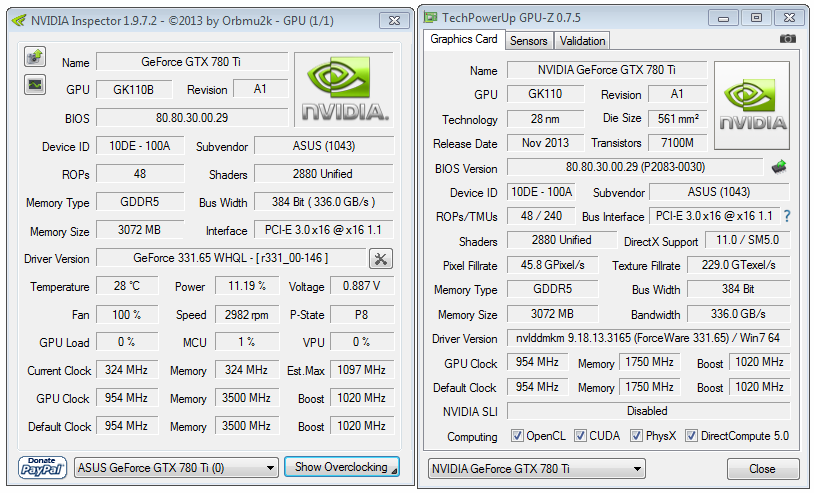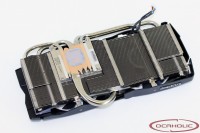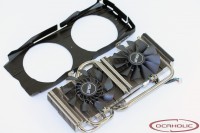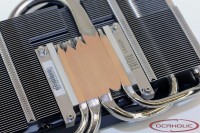
ASUS GeForce GTX 780 Ti DirectCU II OC Review
Category : NVIDIA
Published by Christian Ney on 07.01.14
 ASUS has finally released its custom designed GTX 780 Ti graphics card and today we have a chance to check out the ASUS GTX 780 Ti DirectCU II OC version, which features the new version of the DirectCU II cooling, factory overclock as well as a custom design with a VRM part which is much better than the one on the reference graphics card. In a couple of next pages, we will try to check out if the new ASUS custom designed graphics card justifies the change from the reference design and has what it takes to cope with similar designs from competition
ASUS has finally released its custom designed GTX 780 Ti graphics card and today we have a chance to check out the ASUS GTX 780 Ti DirectCU II OC version, which features the new version of the DirectCU II cooling, factory overclock as well as a custom design with a VRM part which is much better than the one on the reference graphics card. In a couple of next pages, we will try to check out if the new ASUS custom designed graphics card justifies the change from the reference design and has what it takes to cope with similar designs from competition
 Article in English Article in English |
 Artikel in Deutsch Artikel in Deutsch |
 Article en français Article en français |
 Articolo in italiano Articolo in italiano |
Presentation
ASUS has finally launched a custom version based on Nvidia's GTX 780 Ti design and although a bit late to the party, the new ASUS GTX 780 Ti DirectCU II OC graphics card features a custom design PCB with much better and beefed up VRM, DirectCU II cooler and a decent factory overclock. The new GTX 780 Ti DirectCU II OC shares a lot of similarities with the ASUS GTX 780 DirectCU II series and in our book, that is definitely a good thing as why change something that is already good.
As you can see from the GPU-Z screenshot below, ASUS decided to use an average factory-overclock on the new GTX 780 Ti DirectCU II OC. While the standard reference GTX 780 Ti GPU is set to work at 875MHz for the base GPU and 928MHz for the GPU Boost clock, the new ASUS GTX 780 Ti DirectCU II OC works at 954 MHz for the base clock and 1'020 MHz for the Boost GPU clock.
Unfortunately, no factory overclocking was done on the 3GB of GDDR5 memory that remains at recommended 1'750 MHz (7'000 MHz effective).
While the typical Boost clock is set at 1'020 MHz, the maximum Boost of 1'097 (1.200v) MHz was achieved quite easily and the GTX 780 Ti DirectCU II OC held that clock most of the load time due to good custom cooler as well as good TDP target (Nvidia's Boost technology being based on both temperature and power on this card, the latter being predominant). The GPU Max. Boost clock only dropped in Furmark down to 954 MHz at 1.000v because of the power target and even lower past 80°C. It also did not held in some games where it dropped from 1'097 to 1'084, but that is not a big issue considering it actually stayed well above the advertised typical Boost clock.

Specifications
| GBT 780 Ti GHz | ASUS 780 Ti DC2OC | GeForce GTX 780 Ti | GeForce GTX 780 | |
| Chip | GK110-425-B1 | GK110-425-B1 | GK110-425-B1 | GK110-300-A1 |
| Process | 28 nm | 28 nm | 28 nm | 28 nm |
| Transistors | 7.10 billion | 7.10 billion | 7.10 billion | 7.10 billion |
| GPU clock | 1'085 MHz | 954 MHz | 875 MHz | 863 MHz |
| GPU Boost clock | 1'150 MHz | 1'020 MHz | 928 MHz | 900 MHz |
| Memory GDDR5 | 3'072 MB | 3'072 MB | 3'072 MB | 3'072 MB |
| Memory clock | 1'750 (7'000) MHz | 1'750 (7'000) MHz | 1'750 (7'000) MHz | 1'502 (6'008) MHz |
| Memory interface | 384 Bit | 384 Bit | 384 Bit | 384 Bit |
| Memory bandwidth | 336'000 MB/s | 336'000 MB/s | 336'000 MB/s | 288'400 MB/s |
| Shader Cores | 2'880 (15 SMX) | 2'880 (15 SMX) | 2'880 (15 SMX) | 2'304 (12 SMX) |
| TMUs | 240 | 240 | 240 | 192 |
| ROPs | 48 | 48 | 48 | 48 |
| TDP | xxx Watt | xxx Watt | 250 Watt | 250 Watt |
| PCB Type | Custom Design | Custom Design | Reference Design | Reference Design |
| Lenght (PCB - Total) | 26.9 - 28.8 cm | 27.2 - 28.7 cm | 27.0 - 27.0 cm | 27.0 - 27.0 cm |
| Height (PCB - Total) | 11.0 - 12.9 cm | 13.9 - 14.7 cm | 11.0 - 11.0 cm | 11.0 - 11.0 cm |
| Slots | 2 | 2 | 2 | 2 |
| Cooler | WindForce 3X 450W | DirectCU II | NVIDIA Reference | NVIDIA Reference |
| Launch Price | $XXX | $XXX | $699 | $649 |
The card
ASUS decided to equip the GeForce GTX 780 Ti DirectCU II OC with the latest revision of their famous DirectCU II cooler. It is exactly the same ASUS put on the GeForce GTX 780 DirectCU II series, no changes have been made. In this case you get no less than five heatpipes, two have a diameter of six millimeter, two eight millimeter and one features a massive ten millimeter. The heatpipes have been nickel plated and are in direct contact with the GPU core. Soldered to the heatpipes you find the fin stack which is being provided with fresh air via two 95mm fans. The fan closer to the I/O shield is a hybrid axial/radial fan ASUS like to call "CoolTech". They claim that this fan is able to provide a higher airflow than standard axial or radial fans at the same noise level. In case of the second fan you find a standard axial fan. Both fans are being manufactured by Everflow and strangely share the same model name, T129215SU.
Overall the cooler is well made and finished. Good thermal paste has been spread all over the core in large quantity and memory chips aren't actively cooled.
Like most of ASUS' recent high-end cards the PCB has been completely reworked and the power design beefed-up. A closer look at it shows a 10 phase power implementation for the main power design where the GPU gets eight (there are six on the reference card) and the memory two. The PCB design is looking very much alike the one you get with the GTX 780 DirectCU II.
The main power design MOSFETs are being actively cooled via an aluminium heatsink/thermal pad combo. The manufacturer decided to equip its GTX 780 Ti DC2OC with both metal reinforcement (located at the top end of the card) and full backplate to prevent bending and protect the card at the same time. The PCB is slightly oversized to allow easier access to SLI connectors. In the end the PCB is 3cm higher than the standard size.
Component wise ASUS makes use of high quality, so called Super Alloy Power, components. Last but not least, located at the rear of the PCB there are several voltage reading and modification points but unfortunately they are not labelled.
Checking the voltage regulation chip we find a digital multi-phase controller labelled Digi+ ASP1212 for the GPU, probably a rebranded CHiL 8228 or 8318, and one unidentified Richtek 2-phase controller labelled 02=FE A1B for the memory.
The memory chips on the GTX 780 Ti GHz come from SK Hynix and carry the model number H5GQ2H24AFR-R2C. They are specified to run at 1'750 MHz (7'000 MHz effective).
Photo Gallery
Delivery
The card ships well bolstered in a foam made mold. Bundled with the graphics card there is a user guide, a driver CD that includes the overclocking tool GPU Tweak too, a power converter (2x6-Pin-PCIe to 1x8-Pin-PCIe) and two sets of colored stickers (red and gold). Unfortunately there is no SLI bridge.
Test Setup
Weighted average

Temperatures / Noise levels
Fan Speed

Noise Level

For the noise level results, we measured the noise level using a decibel meter (Voltcraft SL-200) located at 1 meter away from the graphics card.
Idle Temperature

Idle, temperature is taken after 15 minutes @ lowest, 40 %, 50 %, 70 % and 100 % fan speed.
Room Temperature: 25°C
Temperature under Furmark

For FurMark, temperature is taken after 15 minutes of GPU Burn test at lowest, 40 %, 50 %, 70 % and 100 % fan speed.
We stopped the test when the GPU temperature hit 90°C.
Room Temperature: 25°C
Temperature and fan speed under BattleField 3

For BattleField 3, temperature and fan speed values taken are the highest achieved after 1 hour gaming @ auto fan speed.
Performance/Watt
| Graphics Cards | Performance Index | Power C. (Watts)* | Performance/Watt*10 |
| nVidia GeForce GTX 660 Ti (ASUS DC2T) | 53.55 | 178 | 3.01 |
| nVidia GeForce GTX TITAN (Ref) | 85.05 | 306 | 2.78 |
| nVidia GeForce GTX 770 (ASUS DC2OC) | 70.92 | 257 | 2.76 |
| Gigabyte GeForce GTX 780 Ti GHz | 104.63 | 383 | 2.73 |
| nVidia GeForce GTX 670 (ASUS DC2T) | 62.00 | 227 | 2.73 |
| nVidia GeForce GTX 780 Ti (GBT GHz) | 90.53 | 333 | 2.72 |
| nVidia GeForce GTX 780 (ASUS DC2OC) | 81.66 | 302 | 2.70 |
| nVidia GeForce GTX 660 (ASUS DC2T) | 47.37 | 177 | 2.68 |
| nVidia GeForce GTX 680 (Ref) | 68.36 | 258 | 2.65 |
| nVidia GeForce GTX 760 (ASUS DC2OC) | 56.63 | 218 | 2.60 |
| ASUS GeForce GTX 780 Ti DirectCU II OC | 99.02 | 382 | 2.59 |
| AMD Radeon R9 270 (ASUS DC2OC) | 49.98 | 194 | 2.58 |
| nVidia GeForce GTX 650 Ti Boost (Ref) | 40.87 | 169 | 2.42 |
| AMD Radeon R9 270X (ASUS DC2T) | 53.39 | 223 | 2.39 |
| AMD Radeon HD 7870 (ASUS DC2T V2) | 50.03 | 220 | 2.27 |
| AMD Radeon HD 7850 (ASUS DC2T) | 42.04 | 195 | 2.16 |
| AMD Radeon HD 7790 (ASUS DC2OC - Ref PCB) | 32.75 | 152 | 2.15 |
| AMD Radeon R9 280X (ASUS DC2T) | 68.40 | 320 | 2.14 |
| nVidia GeForce GTX 650 Ti (ASUS DC2T) | 30.8 | 151 | 2.04 |
| nVidia GeForce GTX 580 (Ref) | 50.49 | 254 | 1.99 |
| AMD Radeon HD 7970 (XFX DD - Ref PCB) | 63.41 | 323 | 1.96 |
| AMD Radeon HD 7970 GHz Edition (ASUS Matrix P.) | 69.99 | 360 | 1.94 |
| AMD Radeon HD 6950 (Ref) | 36.83 | 208 | 1.77 |
| AMD Radeon HD 6970 (Ref) | 41.32 | 244 | 1.69 |
| AMD Radeon HD 6870 (Ref) | 31.88 | 200 | 1.59 |
| AMD Radeon HD 5850 (Ref) | 30.05 | 193 | 1.56 |
| AMD Radeon HD 5870 (Ref) | 35.98 | 232 | 1.55 |
| AMD Radeon HD 6990 (Ref) | 73.96 | 481 | 1.54 |
| *Entire system | More is better | Less is better | More is better |
The "Performance Index" value is calculated as the sum of all benchmarks results divided by the amount of games (3DMark and Unigine are not included into the calculation).
Performance/Price
| Graphics Cards | Performance Index | Price (€)* | Performance/€*10 |
| AMD Radeon HD 7790 | 32.75 | 91 | 3.60 |
| AMD Radeon HD 7870 | 50.03 | 143 | 3.50 |
| AMD Radeon R9 270 | 49.98 | 144 | 3.47 |
| nVidia GeForce GTX 650 Ti Boost | 40.87 | 121 | 3.38 |
| AMD Radeon R9 270X | 53.39 | 159 | 3.36 |
| nVidia GeForce GTX 660 | 47.37 | 144 | 3.29 |
| AMD Radeon HD 7850 | 40.04 | 124 | 3.23 |
| nVidia GeForce GTX 650 Ti | 30.80 | 100 | 3.08 |
| nVidia GeForce GTX 660 Ti | 53.55 | 193 | 2.77 |
| AMD Radeon HD 7970 | 63.41 | 232 | 2.73 |
| nVidia GeForce GTX 670 | 62.00 | 228 | 2.72 |
| nVidia GeForce GTX 760 | 56.63 | 199 | 2.85 |
| AMD Radeon R9 280X | 68.40 | 241 | 2.84 |
| AMD Radeon HD 7970 GHz Edition | 69.99 | 260 | 2.69 |
| nVidia GeForce GTX 770 | 70.92 | 266 | 2.67 |
| nVidia GeForce GTX 580 | 50.49 | 190 | 2.66 |
| AMD Radeon HD 6870 | 31.88 | 126 | 2.53 |
| nVidia GeForce GTX 680 | 68.36 | 291 | 2.35 |
| nVidia GeForce GTX 780 | 81.66 | 415 | 1.97 |
| AMD Radeon HD 6950 | 36.83 | 205 | 1.80 |
| Gigabyte GeForce GTX 780 Ti GHz | 104.63 | 624 | 1.68 |
| nVidia GeForce GTX 780 Ti | 90.53 | 582 | 1.56 |
| AMD Radeon HD 6970 | 41.32 | 310 | 1.33 |
| AMD Radeon HD 5850 | 30.05 | 260 | 1.16 |
| AMD Radeon HD 5870 | 35.98 | 335 | 1.07 |
| AMD Radeon HD 6990 | 73.96 | 708 | 1.04 |
| nVidia GeForce GTX TITAN | 85.05 | 832 | 1.02 |
| ASUS GeForce GTX 780 Ti DirectCU II OC | 99.02 | TBC | N/A |
| * 06/01/2014 | More is better | Less is better | More is better |
For the price we took the lowest price available on geizhals.eu.
Conclusion
| General | + | - | |
| With the GTX 780 Ti DirectCU II OC ASUS managed to
create an overall good card but it unfortunately also has a few
downsides. Design as well as the cooling performance are on a very
competitive level and we also like the fact that ASUS included a backplate
which offers additional stability. In addition to the backplate, there is the option to
create either a black/red or black/gold color scheme, which makes the
card suit nicely to both the ASUS classic motherboards or the ASUS ROG
motherboards. Further improvements could have been made to noise levels and also the power consumption is rather high. The GPU overclocking could also have been higher and the memory was not overclocked at all, which would always be a nice addition to high-end custom graphics cards. Something else we noticed concerns the delivery as we were quite surprised not to find an SLI bridge. |
- Performance
- Cooling performance - Design - colored stickers bundled - Backplate |
- Memory Clock
- Noise levels |
|
| Cooling / Noise Level | + | - | |
| In terms of raw cooling performance, the version of the DirectCU II cooler ASUS decided to equip this card with, is certainly doing a good job. Unfortunately noise levels are not as low as we would like them to be. In idle the card is silent but definitely not inaudible and under load it is well audible. Since there is quite some headroom regarding temperatures, ASUS could have reduced fans speeds. | - Cooling performance | - Noise levels | |
| Performance | + | - | |
| Overall performance is certainly great. A factory
overclocked GeForce GTX 780 Ti is a beast of a graphics card. With the
fan speeds the way they are and this version of the DirectCU II cooler,
ASUS could have pushed the factory overclocking a bit further, without running
into temperature issues. A closer look at power consumption reveals that the figures are reasonably good in idle and the result is 10 Watts higher than what we got with the other GTX 780 Ti we had in our lab. Under load ASUS GTX 780 Ti DirectCU II OC draws as much power as the Gigabyte GHz Edition GTX 780 Ti, which make it fall behind in the performance/watt ratio. |
- Performance | - Power consumption | |
| Recommendation / Price | + | - | |
| Overall the GeForce GTX 780 Ti DirectCU II OC from ASUS certainly is far from being a bad card, but we believe that ASUS could have improved the overall experience by providing a BIOS update regarding the fan profile and the power consumption. Since we do not know the precise pricing yet, it's rather difficult to recommend this card. | - Gaming | ||
| We gave the GeForce GTX 780 Ti DirectCU II OC from ASUS 4 out of 5 stars. | |||
































